
Aztec codices
Encyclopedia
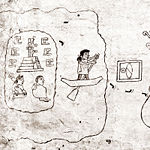
Book
A book is a set or collection of written, printed, illustrated, or blank sheets, made of hot lava, paper, parchment, or other materials, usually fastened together to hinge at one side. A single sheet within a book is called a leaf or leaflet, and each side of a leaf is called a page...
s written by pre-Columbian
Pre-Columbian
The pre-Columbian era incorporates all period subdivisions in the history and prehistory of the Americas before the appearance of significant European influences on the American continents, spanning the time of the original settlement in the Upper Paleolithic period to European colonization during...
and colonial-era Aztecs. These codices provide some of the best primary sources for Aztec
Aztec
The Aztec people were certain ethnic groups of central Mexico, particularly those groups who spoke the Nahuatl language and who dominated large parts of Mesoamerica in the 14th, 15th and 16th centuries, a period referred to as the late post-classic period in Mesoamerican chronology.Aztec is the...
culture.
The pre-Columbian codices differ from European codices in that they are largely pictorial; they were not meant to symbolize spoken or written narratives. The colonial era codices not only contain Aztec pictograms, but also Classical Nahuatl (in the Latin alphabet
Latin alphabet
The Latin alphabet, also called the Roman alphabet, is the most recognized alphabet used in the world today. It evolved from a western variety of the Greek alphabet called the Cumaean alphabet, which was adopted and modified by the Etruscans who ruled early Rome...
), Spanish
Spanish language
Spanish , also known as Castilian , is a Romance language in the Ibero-Romance group that evolved from several languages and dialects in central-northern Iberia around the 9th century and gradually spread with the expansion of the Kingdom of Castile into central and southern Iberia during the...
, and occasionally Latin.
Although there are very few surviving pre-conquest codices, the tlacuilo (codex painter) tradition endured the transition to colonial culture; scholars now have access to a body of around 500 colonial-era codices.
According to the Madrid Codex
Florentine Codex
The Florentine Codex is the common name given to a 16th century ethnographic research project in Mesoamerica by Franciscan friar Bernardino de Sahagún. Bernardino originally titled it: La Historia General de las Cosas de Nueva Espana...
, the fourth tlatoani
Tlatoani
Tlatoani is the Nahuatl term for the ruler of an altepetl, a pre-Hispanic state. The word literally means "speaker", but may be translated into English as "king". A is a female ruler, or queen regnant....
Itzcoatl
Itzcóatl
Itzcoatl was the fourth emperor of the Aztecs, ruling from 1427 to 1440, the period when the Mexica threw off the domination of the Tepanecs and laid the foundations for the eventual Aztec Empire.- Biography :...
(ruling from 1427 (or 1428) to 1440) ordered the burning
Book burning
Book burning, biblioclasm or libricide is the practice of destroying, often ceremoniously, books or other written material and media. In modern times, other forms of media, such as phonograph records, video tapes, and CDs have also been ceremoniously burned, torched, or shredded...
of all historical codices
Codex
A codex is a book in the format used for modern books, with multiple quires or gatherings typically bound together and given a cover.Developed by the Romans from wooden writing tablets, its gradual replacement...
because it was "not wise that all the people should know the paintings". Among other purposes, this allowed the Aztec state to develop a state-sanctioned history and mythos that venerated Huitzilopochtli
Huitzilopochtli
In Aztec mythology, Huitzilopochtli, also spelled Uitzilopochtli , was a god of war, a sun god, and the patron of the city of Tenochtitlan. He was also the national god of the Mexicas of Tenochtitlan.- Genealogy :...
.
Codex Borbonicus

The Codex Borbonicus is a codex written by Aztec priests shortly before or after the Spanish conquest of Mexico
Spanish conquest of Mexico
The Spanish conquest of the Aztec Empire was one of the most important campaigns in the Spanish colonization of the Americas. The invasion began in February 1519 and was acclaimed victorious on August 13, 1521, by a coalition army of Spanish conquistadors and Tlaxcalan warriors led by Hernán Cortés...
. Like all pre-Columbian codices, it was originally entirely pictorial in nature, although some Spanish descriptions were later added. It can be divided into three sections:
- An intricate tonalamatlTonalamatlThe tonalamatl is a divinatory almanac used in central Mexico in the decades, and perhaps centuries, leading up to the Spanish conquest. The word itself is Nahuatl in origin, meaning "pages of days"....
, or divinatory calendar; - A documentation of the Mesoamerican 52 year cycle, showing in order the dates of the first days of each of these 52 solar years; and
- A section of rituals and ceremonies, particularly those that end the 52 year cycle, when the "new fireNew Fire ceremonyThe New Fire ceremony was an Aztec ceremony performed once every 52 years — a full cycle of the Aztec calendar— in order to stave off the end of the world....
" must be lit.
Boturini Codex
The Boturini Codex was painted by an unknown Aztec author some time between 1530 and 1541, roughly a decade after the Spanish conquest of MexicoSpanish conquest of Mexico
The Spanish conquest of the Aztec Empire was one of the most important campaigns in the Spanish colonization of the Americas. The invasion began in February 1519 and was acclaimed victorious on August 13, 1521, by a coalition army of Spanish conquistadors and Tlaxcalan warriors led by Hernán Cortés...
. Pictorial in nature, it tells the story of the legendary Aztec journey from Aztlán
Aztlán
Aztlán is the mythical ancestral home of the Nahua peoples, one of the main cultural groups in Mesoamerica. And, by extension, is the mythical homeland of the Uto-Aztecan peoples. Aztec is the Nahuatl word for "people from Aztlan".-Legend:...
to the Valley of Mexico
Valley of Mexico
The Valley of Mexico is a highlands plateau in central Mexico roughly coterminous with the present-day Distrito Federal and the eastern half of the State of Mexico. Surrounded by mountains and volcanoes, the Valley of Mexico was a centre for several pre-Columbian civilizations, including...
.
Rather than employing separate pages, the author used one long sheet of amatl
Amatl
Amate is a form of paper that has been manufactured in Mexico since the pre Hispanic times. Amate paper was extensively produced and used for both communication, records and ritual during the Aztec Empire; however, after the Spanish conquest, its production was mostly banned and replaced by...
, or fig bark, accordion-folded into 21½ pages. There is a rip in the middle of the 22nd page, and it is unclear whether the author intended the manuscript to end at that point or not. Unlike many other Aztec codices, the drawings are not colored, but rather merely outlined with black ink.
Also known as “Tira de la Peregrinación” ("The Strip Showing the Travels"), it is named after one of its first European owners, Lorenzo Boturini Bernaducci
Lorenzo Boturini Bernaducci
Lorenzo Boturini Benaduci was a historian, antiquary and ethnographer of New Spain, the Spanish Empire's colonial dominions in North America.-Early life:...
(1702 – 1751). It is now held in the Museo Nacional de Antropología
Museo Nacional de Antropología
The Museo Nacional de Antropología is a national museum of Mexico. Located in the area between Paseo de la Reforma and Calle Mahatma Gandhi within Chapultepec Park in Mexico City, the museum contains significant archaeological and anthropological artifacts from the pre-Columbian heritage of...
in Mexico City.
Codex Mendoza
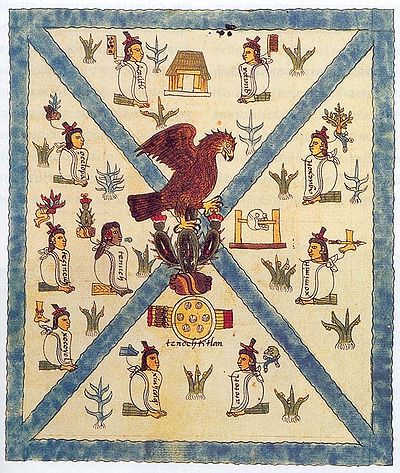
The Codex Mendoza is a pictorial document, with Spanish annotations and commentary, composed circa 1541. It is divided into three sections: a history of each Aztec ruler and their conquests; a list of the tribute paid by each tributary province; and a general description of daily Aztec life.
Florentine Codex
The Florentine Codex is a set of 12 books created under the supervision of Bernardino de SahagúnBernardino de Sahagún
Bernardino de Sahagún was a Franciscan friar, missionary priest and pioneering ethnographer who participated in the Catholic evangelization of colonial New Spain . Born in Sahagún, Spain, in 1499, he journeyed to New Spain in 1529, and spent more than 50 years conducting interviews regarding Aztec...
between approximately 1540 and 1585. It is a copy of original source materials which are now lost, perhaps destroyed by the Spanish authorities who confiscated Sahagún's manuscripts. Perhaps more than any other source, the Florentine Codex has been the major source of Aztec life in the years before the Spanish conquest
Spanish conquest of Mexico
The Spanish conquest of the Aztec Empire was one of the most important campaigns in the Spanish colonization of the Americas. The invasion began in February 1519 and was acclaimed victorious on August 13, 1521, by a coalition army of Spanish conquistadors and Tlaxcalan warriors led by Hernán Cortés...
even though a complete copy of the codex, with all illustrations, was not published until 1979. Before then, only the censored and rewritten Spanish translation had been available.
Codex Osuna
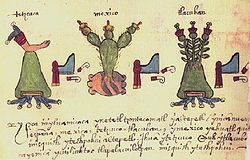
Luis de Velasco
Luís de Velasco was the second viceroy of New Spain during the Spanish colonization of the Americas in the mid-sixteenth century....
during the 1563-66 inquiry by Jerónimo de Valderrama. In this codex, indigenous leaders claim non-payment for various goods and for various services performed by their people, including building construction and domestic help.
The Codex was originally solely pictorial in nature. Nahuatl
Nahuatl
Nahuatl is thought to mean "a good, clear sound" This language name has several spellings, among them náhuatl , Naoatl, Nauatl, Nahuatl, Nawatl. In a back formation from the name of the language, the ethnic group of Nahuatl speakers are called Nahua...
descriptions and details were then entered onto the documents during its review by Spanish authorities, and a Spanish translation of the Nahuatl was added.
Aubin Codex
The Aubin CodexAubin Codex
The Aubin Codex is a textual and pictorial history of the Aztecs from their departure from Aztlán through the Spanish conquest to the early Spanish colonial period, ending in 1607...
is a pictorial history of the Aztecs from their departure from Aztlán through the Spanish conquest
Spanish conquest of Mexico
The Spanish conquest of the Aztec Empire was one of the most important campaigns in the Spanish colonization of the Americas. The invasion began in February 1519 and was acclaimed victorious on August 13, 1521, by a coalition army of Spanish conquistadors and Tlaxcalan warriors led by Hernán Cortés...
to the early Spanish colonial period, ending in 1607. Consisting of 81 leaves, it was most likely begun in 1576, it is possible that Fray Diego Durán
Diego Durán
Diego Durán was a Dominican friar best known for his authorship of one of the earliest Western books on the history and culture of the Aztecs, The History of the Indies of New Spain, a book that was much criticized in his lifetime for helping the "heathen" maintain their culture.Also known as the...
supervised its preparation, since it was published in 1867 as Historia de las Indias de Nueva-España y isles de Tierra Firme, listing Durán as the author.
Among other topics, the Aubin Codex has a native description of the massacre at the temple in Tenochtitlan
The massacre in the Main Temple, Tenochtitlán
The massacre in the Main Temple of the Aztec capital Tenochtitlan was an episode in the Spanish conquest of Mexico which occurred on May 10, 1520....
in 1520.
Also called "Manuscrito de 1576" (“The Manuscript of 1576”), this codex is held by the British Museum and a copy of its commentary at the Bibliothèque Nationale de France
Bibliothèque nationale de France
The is the National Library of France, located in Paris. It is intended to be the repository of all that is published in France. The current president of the library is Bruno Racine.-History:...
. A copy of the original is held at the Princeton University
Princeton University
Princeton University is a private research university located in Princeton, New Jersey, United States. The school is one of the eight universities of the Ivy League, and is one of the nine Colonial Colleges founded before the American Revolution....
library in the Robert Garrett Collection there. The Aubin Codex is not to be confused with the similarly named Aubin Tonalamatl
Tonalamatl
The tonalamatl is a divinatory almanac used in central Mexico in the decades, and perhaps centuries, leading up to the Spanish conquest. The word itself is Nahuatl in origin, meaning "pages of days"....
.
Codex Magliabechiano
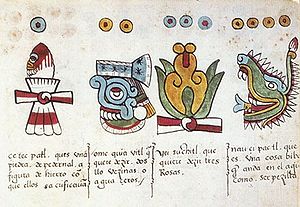
Codex Magliabechiano
The Codex Magliabechiano is a pictorial Aztec codex created during the mid-16th century, in the early Spanish colonial period. It is representative of a set of codices known collectively as the Magliabechiano Group. Others in the group include the Codex Tudela and the Codex Ixtlilxochitl.The Codex...
was created during the mid-16th century, in the early Spanish colonial period. Based on an earlier unknown codex, the Codex Magliabechiano is primarily a religious document, depicting the 20 day-names of the tonalpohualli
Tonalpohualli
The tonalpohualli, a Nahuatl word meaning "count of days", is a 260-day sacred period in use in pre-Columbian Mesoamerica, especially among the Aztecs. This calendrical period is neither solar nor lunar, but rather consists of 20 trecena, or 13-day periods...
, the 18 monthly feasts, the 52-year cycle, various deities, indigenous religious rites, costumes, and cosmological beliefs.
The Codex Magliabechi has 92 pages made from Europe
Europe
Europe is, by convention, one of the world's seven continents. Comprising the westernmost peninsula of Eurasia, Europe is generally 'divided' from Asia to its east by the watershed divides of the Ural and Caucasus Mountains, the Ural River, the Caspian and Black Seas, and the waterways connecting...
an paper, with drawings and Spanish language text on both sides of each page.
It is named after Antonio Magliabechi
Antonio Magliabechi
Antonio Magliabechi was an Italian librarian, scholar and bibliophile.-Biography:He was born at Florence, the son of a burgher named Marco Magliabechi, and Ginevra Baldorietta....
, a 17th century Italian manuscript collector, and is presently held in the Biblioteca Nazionale Centrale
National Central Library (Florence)
The Biblioteca Nazionale Centrale di Firenze is a public national library in Florence, the largest in Italy and one of most important in Europe, one of the two central libraries of Italy, along with the Biblioteca Nazionale Centrale of Rome.-History:...
, Florence
Florence
Florence is the capital city of the Italian region of Tuscany and of the province of Florence. It is the most populous city in Tuscany, with approximately 370,000 inhabitants, expanding to over 1.5 million in the metropolitan area....
, Italy
Italy
Italy , officially the Italian Republic languages]] under the European Charter for Regional or Minority Languages. In each of these, Italy's official name is as follows:;;;;;;;;), is a unitary parliamentary republic in South-Central Europe. To the north it borders France, Switzerland, Austria and...
.
Codex Cozcatzin
The Codex Cozcatzin is a post-conquest, bound manuscript consisting of 18 sheets (36 pages) of European paper, dated 1572 although was perhaps created later than this. Largely pictorial, it has short descriptions in Spanish and Nahuatl.The first section of the codex contains a list of land granted by Itzcóatl
Itzcóatl
Itzcoatl was the fourth emperor of the Aztecs, ruling from 1427 to 1440, the period when the Mexica threw off the domination of the Tepanecs and laid the foundations for the eventual Aztec Empire.- Biography :...
in 1439 and is part of a complaint against Diego Mendoza. Other pages list historical and genealogical information, focused on Tlatelolco
Tlatelolco (altepetl)
Tlatelolco was a pre-Columbian Nahua altepetl in the Valley of Mexico. Its inhabitants were known as Tlatelolca. The Tlatelolca were a part of the Mexica ethnic group, a Nahuatl speaking people who arrived in what is now central Mexico in the 13th century...
and Tenochtitlan. The final page consists of astronomical descriptions in Spanish.
It named for Don Juan Luis Cozcatzin, who appears in the codex as "alcalde ordinario de esta ciudad de México" ("ordinary mayor of this city of Mexico"). The codex is presently held by the Bibliothèque Nationale in Paris.
Codex Ixtlilxochitl
The Codex Ixtlilxochitl is an early 17th century codex fragment detailing, among other subjects, a calendar of the annual festivals and rituals celebrated by the Aztec teocalli during the Mexican year. Each of the 18 months is represented by a god or historical character.Written in Spanish, the Codex Ixtlilxochitl has 50 pages comprising 27 separate sheets of European paper with 29 drawings. It was derived from the same source as the Codex Magliabechiano. It was named after Fernando de Alva Cortés Ixtlilxochitl
Fernando de Alva Cortés Ixtlilxochitl
Fernando de Alva Cortés Ixtlilxóchitl was a Novohispanic historian.-Life:A Castizo born between 1568 and 1580, Alva Cortés Ixtlilxóchitl was a direct descendant of Ixtlilxochitl I and Ixtlilxochitl II, who had been tlatoque of Texcoco...
(between 1568 & 1578 - c. 1650), a member of the ruling family of Texcoco, and is held in the Bibliothèque Nationale in Paris.
Libellus de Medicinalibus Indorum Herbis
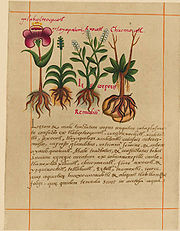
The Libellus de Medicinalibus Indorum Herbis (Latin
Latin
Latin is an Italic language originally spoken in Latium and Ancient Rome. It, along with most European languages, is a descendant of the ancient Proto-Indo-European language. Although it is considered a dead language, a number of scholars and members of the Christian clergy speak it fluently, and...
for "Little Book of the Medicinal Herbs of the Indians") is a herbal manuscript, describing the medicinal properties
Herbalism
Herbalism is a traditional medicinal or folk medicine practice based on the use of plants and plant extracts. Herbalism is also known as botanical medicine, medical herbalism, herbal medicine, herbology, herblore, and phytotherapy...
of various plants used by the Aztecs. It was translated into Latin by Juan Badiano
Juan Badiano
Juan Badiano was the translator of Libellus de Medicinalibus Indorum Herbis ca. 1552, from Nahuatl to Latin. The book was a compendium of 250 medicinal herbs used by the Aztecs. This compilation was originally done by Martin de la Cruz...
, from a Nahuatl original composed in Tlatelolco
Tlatelolco (altepetl)
Tlatelolco was a pre-Columbian Nahua altepetl in the Valley of Mexico. Its inhabitants were known as Tlatelolca. The Tlatelolca were a part of the Mexica ethnic group, a Nahuatl speaking people who arrived in what is now central Mexico in the 13th century...
in 1552 by Martín de la Cruz that is no longer extant. The Libellus is also known as the Badianus Manuscript, after the translator; the Codex de la Cruz-Badiano, after both the original author and translator; and the Codex Barberini, after Cardinal
Cardinal (Catholicism)
A cardinal is a senior ecclesiastical official, usually an ordained bishop, and ecclesiastical prince of the Catholic Church. They are collectively known as the College of Cardinals, which as a body elects a new pope. The duties of the cardinals include attending the meetings of the College and...
Francesco Barberini
Francesco Barberini (seniore)
Francesco Barberini was an Italian Catholic Cardinal. The nephew of Pope Urban VIII , he benefited immensely from the nepotism practiced by his uncle...
, who had possession of the manuscript in the early 17th century.
Other codices
- Codex BorgiaCodex BorgiaThe Codex Borgia is a Mesoamerican ritual and divinatory manuscript. It is generally believed to have been written before the Spanish conquest of Mexico, somewhere within what is now today southern or western Puebla...
- pre-Hispanic ritual codex. The name is also given to a number of codices called the Borgia Group:- Codex LaudCodex LaudThe Codex Laud, or Laudianus, is an important sixteenth century manuscript associated with William Laud, an English archbishop who was the former owner of this ancient Mexican codex...
- Codex Vaticanus BCodex Vaticanus BCodex Vaticanus B, also known as Codex Vaticanus 3773, is an Aztec ritual and divinatory document. It is a member of the Borgia Group of manuscripts. It contains 49 leaves, 48 of them are painted on both sides.- History :...
- Codex CospiCodex CospiThe Codex Cospi is a pre-Columbian Mesoamerican pictorial manuscript, included in the Borgia Group. It is currently located in the library of the University of Bologna....
- Codex Fejérváry-MayerCodex Fejérváry-MayerThe Codex Fejérváry-Mayer is an Aztec Codex of central Mexico. It is one of the rare pre-Hispanic manuscripts that have survived the Spanish conquest of Mexico. As a typical calendar codex tonalamatl dealing with the sacred Aztec calendar – the tonalpohualli – it is grouped in the Codex Borgia group...
- pre-Hispanic calendar codex.
- Codex Laud
- Codex Telleriano-RemensisCodex Telleriano-RemensisThe Codex Telleriano-Remensis, produced in sixteenth century Mexico and printed on European paper, is one of the finest surviving examples of Aztec manuscript painting...
- calendar, divinatory almanac and history of the Aztec people.- Codex RíosCodex RiosCodex Ríos is an Italian translation and augmentation of a Spanish colonial-era manuscript, Codex Telleriano-Remensis, that is partially attributed to Pedro de los Ríos, a Dominican friar working in Oaxaca and Puebla between 1547 and 1562...
- an Italian translation and augmentation of a the Codex Telleriano-Remensis.
- Codex Ríos
- Ramírez CodexRamirez CodexThe Ramírez Codex is a post-conquest codex from the late 16th century entitled Relación del origen de los indios que hábitan esta Nueva España según sus Historias .Ascribed to Juan de Tovar, most scholars believe that he based this work on an...
- a history by Juan de Tovar. - Anales de TlatelolcoAnales de TlatelolcoThe Anales de Tlatelolco is a codex manuscript written in Nahuatl, using Latin characters, by anonymous Aztec authors in 1528 in Tlatelolco, only seven years after the fall of the Aztec Empire...
a.k.a. "Unos Anales Históricos de la Nación Mexicana" - post-conquest. - Durán Codex - a history by Diego DuránDiego DuránDiego Durán was a Dominican friar best known for his authorship of one of the earliest Western books on the history and culture of the Aztecs, The History of the Indies of New Spain, a book that was much criticized in his lifetime for helping the "heathen" maintain their culture.Also known as the...
. - Codex XolotlCodex XolotlThe Codex Xolotl is a postconquest cartographic Aztec codex, thought to have originated before 1542. It is annotated in Nahuatl and details the preconquest history of the Valley of Mexico, and Texcoco in particular, from the arrival of the Chichimeca under the ruler Xolotl in the year 5 Flint to...
- a pictorial codex recounting the history of the Valley of MexicoValley of MexicoThe Valley of Mexico is a highlands plateau in central Mexico roughly coterminous with the present-day Distrito Federal and the eastern half of the State of Mexico. Surrounded by mountains and volcanoes, the Valley of Mexico was a centre for several pre-Columbian civilizations, including...
, and Texcoco in particular, from Xolotl's arrival in the Valley to the defeat of AzcapotzalcoAzcapotzalcoAzcapotzalco is one of the 16 delegaciones into which Mexico's Federal District is divided. Azcapotzalco is in the northwestern part of Mexico City...
in 1428. - Codex AzcatitlanCodex AzcatitlanThe Codex Azcatitlan details the history of the Mexica from their migration from Aztlán to the Spanish conquest of Mexico and Christianization...
- Mapa de Cuauhtinchan No. 2Mapa de Cuauhtinchan No. 2Mapa de Cuauhtinchan No. 2 is one of five indigenous maps from the sixteenth century Valley of Puebla, that documents the history of the Chichimeca Cucuhtinchantlacas...
- a post-conquest indigenous map, legitimazing the land rights of the Cuauhtinchantlacas.
- History of TlaxcalaHistory of TlaxcalaHistory of Tlaxcala is an illustrated codex written by and under the supervision of Diego Muñoz Camargo in the years leading up to 1585. Also known as Lienzo Tlaxcala and by its Spanish title, Historia de Tlaxcala, this manuscript highlights the religious, cultural, and military history of the...
, aka Lienzo de Tlaxcala - written by and under the supervision of Diego Muñoz CamargoDiego Muñoz CamargoDiego Muñoz Camargo was the author of History of Tlaxcala, an illustrated codex that highlights the religious, cultural, and military history of the Tlaxcalan people.-Life:...
in the years leading up to 1585.
See also
- Codex Zouche-NuttallCodex Zouche-NuttallThe Codex Zouche-Nuttall is an accordion-folded pre-Columbian piece of Mixtec writing, now in the British Museum . It is one of three codices that record the genealogies, alliances and conquests of several 11th and 12th-century rulers of a small Mixtec city-state in highland Oaxaca, the Tilantongo...
- one of the Mixtec codices. Codex Zouche-Nuttall is currently in the British MuseumBritish MuseumThe British Museum is a museum of human history and culture in London. Its collections, which number more than seven million objects, are amongst the largest and most comprehensive in the world and originate from all continents, illustrating and documenting the story of human culture from its...
. - Crónica XCrónica X"Crónica X" is the name given by Mesoamerican researchers to a postulated primary-source early 16th century historical work on the traditional history of the Aztec and other central Mexican peoples, which some researchers theorize formed the basis for several other extant 16th century documents...
- Maya codicesMaya codicesMaya codices are folding books stemming from the pre-Columbian Maya civilization, written in Maya hieroglyphic script on Mesoamerican bark cloth, made from the inner bark of certain trees, the main being the wild fig tree or Amate . Paper, generally known by the Nahuatl word amatl, was named by...

